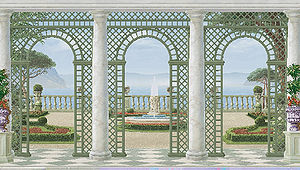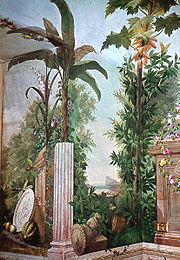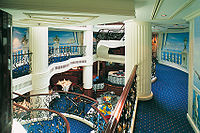
Frescography
Encyclopedia
Frescography is a method for producing murals digitally on paper, canvas, glass or tiles, invented 1998 by German muralist Rainer Maria Latzke
. Frescography uses CAM and digital printing
methods to create murals.

method of the French Papier Peints wallpapers, used by manufacturers like Zuber et cie or Joseph Dufour et Cie
who began developing the procedure during the end of the 18th century. These wallpaper
manufacturers used thousands of engraved woodblocks for the creation of the panorama sceneries, to create wall paper such as the 20 panel Sauvages de la Mer du Pacifique which Jean-Gabriel Charvet
designed for Joseph Dufour et Cie
or the “du Vue de l'Amérique Nord” designed in 1834 by Zuber et cie for the Diplomatic Reception Room of the White House
, where it is still today.
 Unlike woodblock printing
Unlike woodblock printing
, the frescography is based on digitally cut-out motifs which are stored in a database
. To avoid having to work with high resolution files on software such as Photoshop (resulting in long rendering and processing time), new CAM software programs like the Dreamworlds Design Studio allow the composition of mural designs by working with preview files which are later converted to the original resolution. By adding the exact measurements of a wall when starting a new project and even taking architectural elements such as doors windows or beams into consideration, the design will result in an accurately and tailor-fit wall mural.
Once a design is finished, the low resolution motifs are converted into the original high resolution images and are printed on Wide-format printer
s. Unlike the woodblock print consisting of stripes, the frescography is printed on a single piece of
canvas allowing a seamless mural tailor-fit to the walls dimensions. Once produced, the canvas is applied to the wall in a wall-paper-like procedure.
Since the motifs can be placed freely and scaled to the individual wall measurements, the finished piece will look like it was created on-site.

, founded the Institute
of Frescography (IOF) at Utah State University
in Logan
, Utah
. The IOF is a non-profit
institution whose mission is the improvement of public knowledge and interest in the art of mural
and fresco
painting
. It also researches on Art history
, digital
reproduction, printing
processes and materials, and restoration techniques of mural
art.
In cooperation with the German Zentralinstitut für Kunstgeschichte, the IOF houses a 40,000 images archive
of European wall and mural painting
s and the 5,000 image archive “World of Ornaments” which makes it the largest archive of mural and decorative art
in the US.
The archive of European wall and mural paintings covers the period between the Gothic
ages to the end of the 19th century.
The archive of the World of Ornaments consists of 5,000 motifs based on of the two greatest encyclopedic collections of ornament from the 19th century chromo-lithographic
tradition: Auguste Racinet's L“'Ornement polychrome
Volumes I and II“ from 1875-1888 and “M. Dupont-Auberville's L'Ornement des tissus” from 1877.
The IOF also is participating in Museum
and exhibition projects of mural
and fresco
art.
 Frescographies can be found in the Lanner Lehar Hall of the Vienna town hall or the worlds largest cruising ship, Royal Clipper
Frescographies can be found in the Lanner Lehar Hall of the Vienna town hall or the worlds largest cruising ship, Royal Clipper
.
, depending on the material the printer supports.
Commonly frescographies are printed on Wide-format printer
s such as Efi's Vutek printer .
Rainer Maria Latzke
Rainer Maria Latzke is a German artist working in the field of trompe l'oeil and mural painting. He teaches at the Utah State University and is Founder of the Institute of Frescography in Logan, Utah. He also is Honorary Professor of the Shanghai Institute of Visual Art of Fudan University and...
. Frescography uses CAM and digital printing
Digital printing
Digital printing refers to methods of printing from a digital based image directly to a variety of media. It usually refers to professional printing where small run jobs from desktop publishing and other digital sources are printed using large format and/or high volume laser or inkjet printers...
methods to create murals.

History of mural reproduction techniques
The Frescography is based on a similar technique as the woodblock printingWoodblock printing
Woodblock printing is a technique for printing text, images or patterns used widely throughout East Asia and originating in China in antiquity as a method of printing on textiles and later paper....
method of the French Papier Peints wallpapers, used by manufacturers like Zuber et cie or Joseph Dufour et Cie
Joseph Dufour et Cie
Joseph Dufour et Cie, founded 1797 by Joseph and Pierre Dufour, was a s a French Manufacture de Papier Peints et Tissus manufacturer located in Mâcon, France.-General:...
who began developing the procedure during the end of the 18th century. These wallpaper
Wallpaper
Wallpaper is a kind of material used to cover and decorate the interior walls of homes, offices, and other buildings; it is one aspect of interior decoration. It is usually sold in rolls and is put onto a wall using wallpaper paste...
manufacturers used thousands of engraved woodblocks for the creation of the panorama sceneries, to create wall paper such as the 20 panel Sauvages de la Mer du Pacifique which Jean-Gabriel Charvet
Jean-Gabriel Charvet
Jean-Gabriel Charvet , also known as Jean Gabriel Charvet, was a French painter, designer and draftsman who was born in Serrières, Ardèche, France. He studied at the École de Dessin in Lyon under the French artist Donat Nonotte and worked as a designer for the French wallpaper manufacturer Joseph...
designed for Joseph Dufour et Cie
Joseph Dufour et Cie
Joseph Dufour et Cie, founded 1797 by Joseph and Pierre Dufour, was a s a French Manufacture de Papier Peints et Tissus manufacturer located in Mâcon, France.-General:...
or the “du Vue de l'Amérique Nord” designed in 1834 by Zuber et cie for the Diplomatic Reception Room of the White House
White House
The White House is the official residence and principal workplace of the president of the United States. Located at 1600 Pennsylvania Avenue NW in Washington, D.C., the house was designed by Irish-born James Hoban, and built between 1792 and 1800 of white-painted Aquia sandstone in the Neoclassical...
, where it is still today.
The principle of Frescography

Woodblock printing
Woodblock printing is a technique for printing text, images or patterns used widely throughout East Asia and originating in China in antiquity as a method of printing on textiles and later paper....
, the frescography is based on digitally cut-out motifs which are stored in a database
Database
A database is an organized collection of data for one or more purposes, usually in digital form. The data are typically organized to model relevant aspects of reality , in a way that supports processes requiring this information...
. To avoid having to work with high resolution files on software such as Photoshop (resulting in long rendering and processing time), new CAM software programs like the Dreamworlds Design Studio allow the composition of mural designs by working with preview files which are later converted to the original resolution. By adding the exact measurements of a wall when starting a new project and even taking architectural elements such as doors windows or beams into consideration, the design will result in an accurately and tailor-fit wall mural.
Once a design is finished, the low resolution motifs are converted into the original high resolution images and are printed on Wide-format printer
Wide-format printer
Wide-format printers are generally accepted to be any printer with a print width between 17" and 100". Printers over the 100" mark may be called Super-Wide or Grand format. Wide format printers are used to print banners, posters and general signage and in some cases may be more economical than...
s. Unlike the woodblock print consisting of stripes, the frescography is printed on a single piece of
canvas allowing a seamless mural tailor-fit to the walls dimensions. Once produced, the canvas is applied to the wall in a wall-paper-like procedure.
Since the motifs can be placed freely and scaled to the individual wall measurements, the finished piece will look like it was created on-site.

Institute of Frescography
In 2009 the inventor of the Frescography technique, Professor Rainer Maria LatzkeRainer Maria Latzke
Rainer Maria Latzke is a German artist working in the field of trompe l'oeil and mural painting. He teaches at the Utah State University and is Founder of the Institute of Frescography in Logan, Utah. He also is Honorary Professor of the Shanghai Institute of Visual Art of Fudan University and...
, founded the Institute
Institute
An institute is a permanent organizational body created for a certain purpose. Often it is a research organization created to do research on specific topics...
of Frescography (IOF) at Utah State University
Utah State University
Utah State University is a public university located in Logan, Utah. It is a land-grant and space-grant institution and is accredited by the Northwest Commission on Colleges and Universities....
in Logan
Logan
Logan was a Native American leader.Logan may also refer to:- Australia :* Logan City, a local government area in Queensland* Electoral district of Logan, an electoral district in the Queensland Legislative Assembly...
, Utah
Utah
Utah is a state in the Western United States. It was the 45th state to join the Union, on January 4, 1896. Approximately 80% of Utah's 2,763,885 people live along the Wasatch Front, centering on Salt Lake City. This leaves vast expanses of the state nearly uninhabited, making the population the...
. The IOF is a non-profit
Non-profit organization
Nonprofit organization is neither a legal nor technical definition but generally refers to an organization that uses surplus revenues to achieve its goals, rather than distributing them as profit or dividends...
institution whose mission is the improvement of public knowledge and interest in the art of mural
Mural
A mural is any piece of artwork painted or applied directly on a wall, ceiling or other large permanent surface. A particularly distinguishing characteristic of mural painting is that the architectural elements of the given space are harmoniously incorporated into the picture.-History:Murals of...
and fresco
Fresco
Fresco is any of several related mural painting types, executed on plaster on walls or ceilings. The word fresco comes from the Greek word affresca which derives from the Latin word for "fresh". Frescoes first developed in the ancient world and continued to be popular through the Renaissance...
painting
Painting
Painting is the practice of applying paint, pigment, color or other medium to a surface . The application of the medium is commonly applied to the base with a brush but other objects can be used. In art, the term painting describes both the act and the result of the action. However, painting is...
. It also researches on Art history
Art history
Art history has historically been understood as the academic study of objects of art in their historical development and stylistic contexts, i.e. genre, design, format, and style...
, digital
Digital
A digital system is a data technology that uses discrete values. By contrast, non-digital systems use a continuous range of values to represent information...
reproduction, printing
Printing
Printing is a process for reproducing text and image, typically with ink on paper using a printing press. It is often carried out as a large-scale industrial process, and is an essential part of publishing and transaction printing....
processes and materials, and restoration techniques of mural
Mural
A mural is any piece of artwork painted or applied directly on a wall, ceiling or other large permanent surface. A particularly distinguishing characteristic of mural painting is that the architectural elements of the given space are harmoniously incorporated into the picture.-History:Murals of...
art.
In cooperation with the German Zentralinstitut für Kunstgeschichte, the IOF houses a 40,000 images archive
Archive
An archive is a collection of historical records, or the physical place they are located. Archives contain primary source documents that have accumulated over the course of an individual or organization's lifetime, and are kept to show the function of an organization...
of European wall and mural painting
Painting
Painting is the practice of applying paint, pigment, color or other medium to a surface . The application of the medium is commonly applied to the base with a brush but other objects can be used. In art, the term painting describes both the act and the result of the action. However, painting is...
s and the 5,000 image archive “World of Ornaments” which makes it the largest archive of mural and decorative art
Decorative art
The decorative arts is traditionally a term for the design and manufacture of functional objects. It includes interior design, but not usually architecture. The decorative arts are often categorized in opposition to the "fine arts", namely, painting, drawing, photography, and large-scale...
in the US.
The archive of European wall and mural paintings covers the period between the Gothic
Gothic art
Gothic art was a Medieval art movement that developed in France out of Romanesque art in the mid-12th century, led by the concurrent development of Gothic architecture. It spread to all of Western Europe, but took over art more completely north of the Alps, never quite effacing more classical...
ages to the end of the 19th century.
The archive of the World of Ornaments consists of 5,000 motifs based on of the two greatest encyclopedic collections of ornament from the 19th century chromo-lithographic
Chromolithography
Chromolithography is a method for making multi-color prints. This type of color printing stemmed from the process of lithography, and it includes all types of lithography that are printed in color. When chromolithography is used to reproduce photographs, the term photochrom is frequently used...
tradition: Auguste Racinet's L“'Ornement polychrome
Polychrome
Polychrome is one of the terms used to describe the use of multiple colors in one entity. It has also been defined as "The practice of decorating architectural elements, sculpture, etc., in a variety of colors." Polychromatic light is composed of a number of different wavelengths...
Volumes I and II“ from 1875-1888 and “M. Dupont-Auberville's L'Ornement des tissus” from 1877.
The IOF also is participating in Museum
Museum
A museum is an institution that cares for a collection of artifacts and other objects of scientific, artistic, cultural, or historical importance and makes them available for public viewing through exhibits that may be permanent or temporary. Most large museums are located in major cities...
and exhibition projects of mural
Mural
A mural is any piece of artwork painted or applied directly on a wall, ceiling or other large permanent surface. A particularly distinguishing characteristic of mural painting is that the architectural elements of the given space are harmoniously incorporated into the picture.-History:Murals of...
and fresco
Fresco
Fresco is any of several related mural painting types, executed on plaster on walls or ceilings. The word fresco comes from the Greek word affresca which derives from the Latin word for "fresh". Frescoes first developed in the ancient world and continued to be popular through the Renaissance...
art.
Applications of frescographies

Royal Clipper
Royal Clipper is a steel-hulled five masted fully rigged tall ship used as a cruise ship. She was designed by Zygmunt Choreń, and built using an existing steel hull that was modified by the Gdańsk Shipyard, and the Merwede shipyard completed the ship's interior in July 2000...
.
Material & Printers
Since Frescography is based on digital printing methods, various materials ranging from canvas, ceramics, or glass to PVCPVC
Polyvinyl chloride is a plastic.PVC may also refer to:*Param Vir Chakra, India's highest military honor*Peripheral venous catheter, a small, flexible tube placed into a peripheral vein in order to administer medication or fluids...
, depending on the material the printer supports.
Commonly frescographies are printed on Wide-format printer
Wide-format printer
Wide-format printers are generally accepted to be any printer with a print width between 17" and 100". Printers over the 100" mark may be called Super-Wide or Grand format. Wide format printers are used to print banners, posters and general signage and in some cases may be more economical than...
s such as Efi's Vutek printer .

